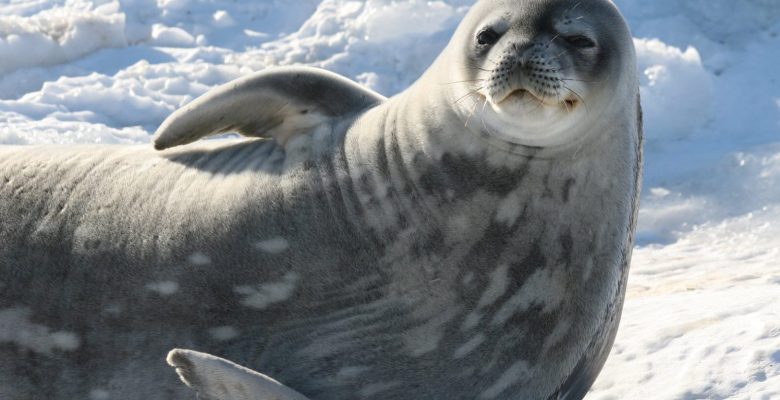By Laurie Henry
Weddell seals are one of Antarctica’s most iconic species. Besides being undeniably charismatic, their range is the southernmost of all seals. They can live up to 30 years in some of the harshest conditions on the planet. Understanding their population trends over time allows scientists to better understand the effects of climate change and commercial fishing.
Weddell seals an indicator of Antarctic health
In Antarctica, the population of Weddell seals in Erebus Bay in the Ross Sea is the southernmost population of mammals in the world. The location of the population is of particular interest, as the Ross Sea is one of the most productive fishing grounds in the Southern Ocean, particularly for krill* and Antarctic toothfish* (commonly known as Chilean bass).
The population studied is ideal for increasing understanding of the population dynamics of long-lived species in the face of climate change and human activities. Indeed, Weddell seals are a key indicator species of the Southern Ocean, i.e. a bioindicator. In clear terms it is a species whose presence or population density provides information on the state of an ecosystem.
Concretely, Weddell seals are sensitive to the availability of food, and very attached to their place of origin. So if the environmental conditions change, causing the sea ice to decrease, the krill below will also decrease, causing the seals to migrate.

The largest colony of Weddell seals in Erebus Bay at Hutton Cliffs in Erebus Bay. © Jay Rotella, 2022
Long-term monitoring crucial and still relevant
The breeding population of Weddell seals in the Ross Sea has been studied intensively since 1968. Seals have been individually marked during the pup-rearing period for 4 decades, with monitoring continuing to be carried out every year.
The long-term database thus constructed, which includes data from more than 28,000 tagged individuals, contains detailed information on populations and even individual animals as identified by tagging. The general objective of this monitoring is to assess how the temporal variation of the marine environment affects the population dynamics of long-lived mammals. This is the case, for example, of long-term climatic fluctuations such as El Niño events, or short-term effects of the local climate.
Life traits that have evolved
According to the recent study by Jay Rotella (J. Rotella, 2022), a researcher at Montana State University, the characteristics of the population of Weddell seals – such as the composition of age classes, the dispersal of animals from their breeding sites, age of first breeding (between 4 and 14 years) and survival rate – have changed over the past 20 years.
Specifically, survival rates are relatively low early in life, such that only 20% of females in a single birth year survive and reproduce. Environmental conditions, as well as characteristics of the mother (her age, age at first reproduction, and reproductive experience), combine to influence the survival prospects of the young.
Nevertheless, Jay Rotella points out that “luck probably plays a major role” in relation to trait variation. The combination of luck and individual characteristics induces that the 20% reproducing have a very different number of young during their life (between 1 and 23 young).
A first more precise observation
This research complements a previous groundbreaking study conducted in 2021 by Rotella (M. LaRue et al., 2021). This was the first direct population estimate, on a large scale, ever carried out on a wild animal species.
In 2021, Jay Rotella and his team, along with more than 330,000 international volunteer citizen scientists, used hundreds of high-resolution satellite images covering large areas of Antarctica to count Weddell seals. Unfortunately, they noticed a decrease in the general population.
In Victoria Land, for example, bordering the Ross Sea, the number of seals spotted in the north has dropped from nearly 2,000 in the 1970s to just four in 2018! Indeed, the seals are moving south because their habitat, the fast ice much further north, is disappearing earlier in the summer. They must therefore find refuge in areas further south.
Combining the results of these two studies, Jay Rotella qualifies in a press release: “We have seen a sharp decline in seal numbers for a few years, but over the past 15 years we have seen a general and noticeable increase in population reproduction”. The impacts of climatic factors on the survival and persistence of seals are a major focus of future studies.
A prize that supports and promotes research efforts
With a $1.4 million National Science Foundation grant to Montana State University, Jay Rotella will continue to study this population of Weddell seals in the Ross Sea from 2022 to 2026.
The research team hopes to better understand population structure, function and genetics and be able to provide key information to predict how the seal population will respond to environmental changes, and extrapolate to other species.
*Krill: Cold sea plankton, made up of small crustaceans.
*Toothfish: carnivorous fish, living in shallow waters where it feeds on crustaceans.


